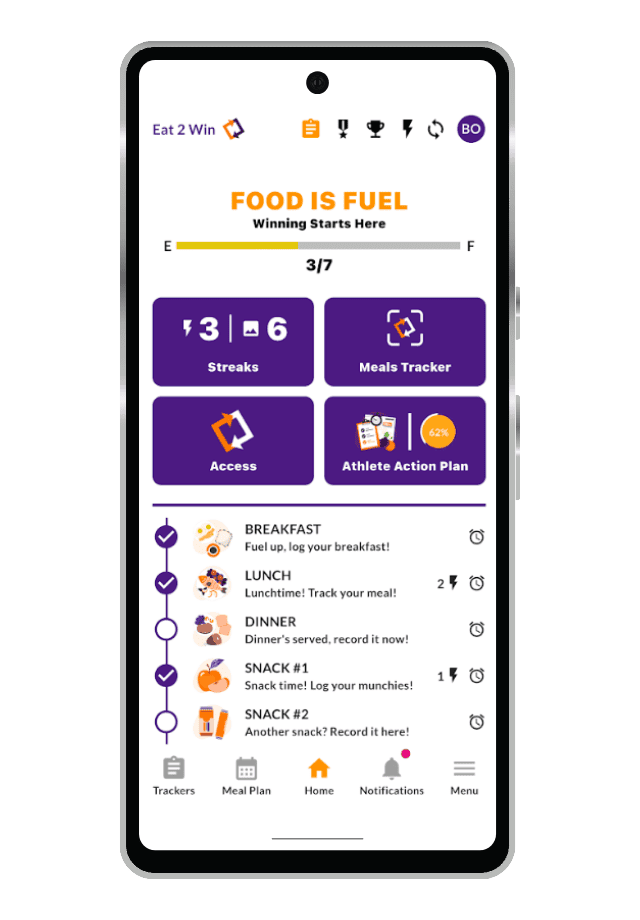
Improve Your Athletic Performance Through Healthy Snacking
Eating in between meals is an ideal way to help athletes obtain and meet their calorie goals for the day, fuel before or after practice, and sustain energy levels throughout the day. Athletes may wonder: What to eat to prepare for a workout? Which snack or meal will speed recovery? What will help sustain mental alertness? Read on to learn healthy snack ideas, see a timeline for athlete snacks consumption, and suggestions for healthy snack ideas on the go.
Listen to the DEEP DIVE
- Healthy Snacks for Peak Athletic Performance00:00
Importance of Healthy Snacking:
Snacking throughout the day, especially for athletes, is important as it helps maintain blood sugar levels, keeps energy levels high, and prevents overeating at meals, or worse late in the evening. Healthy snacking helps athletes feel fuller longer to make healthier choices at meal times instead of eating fried or sugary foods when hunger strikes (3). It keeps blood sugar even by providing fuel on a regular basis, thus avoiding steep drops in blood sugar that can cause irritability or ravenous hunger (4). Healthy snacking is also good for weight control as it helps athletes manage hunger over a period of time instead of eating heavily at night after ignoring hunger cues throughout the day (5). It prevents overeating at night when more food can be stored as fat since fewer calories are burned off at night than as energy throughout the day.
Timeline for Healthy Snacking:
Every athlete knows that no two days are the same. Some days require higher calorie intake that others, depending on training volume and/or intensity. There are many factors to consider when selecting a snack—including hunger level, time of day, pre- or post-workout and weight goals.
Deciding when throughout the day to eat is often called nutrient timing. Nutrient timing is a flashy buzz word that sounds cool when talking about daily fueling, but what does that exactly mean? Nutrient timing is the consumption of foods in and around the time of an exercise session (1). Some research shows it helps performance, while other research shows the timing of eating doesn’t matter as much as long as enough nutrients are consumed throughout the day (1).
This can still leave an athlete feeling confused as to when is the best time to eat certain foods. Eating too heavy of a meal before practice can leave you feeling sluggish as the food has taken over priority in the body, not the exercise. Eating too little before a practice can result in decreased energy and performance and can lead to overeating after practice, which can also cause discomfort. What counts is that athletes are fueling their bodies for performance. It is easier for the human body to consume nutrients throughout the day as opposed to trying to consume everything in three meals.
When should you eat certain types of foods to optimize performance? Fat helps keep you feeling full longer and decreases inflammation. Eating foods that are high in healthy fat (like nuts or fish) are good when you won’t be practicing within 1-2 hours, such as dinners or snacks after breakfast. Ideally, consume protein throughout the day as it helps repair and rebuild your body. Eating eggs at breakfast, a turkey wrap at lunch or a chicken breast at dinner are all good options
Carbohydrates are great sources of instant energy (in the forms of white bread or white rice) like a peanut butter and jelly sandwich right before practice so your body can start out burning that as its primary fuel source. Slower-digesting carbohydrates (known as complex carbohydrates) such as sweet potatoes or brown rice help the body maintain energy levels throughout the day. Eating oatmeal at breakfast or quinoa at dinner will help keep blood sugar levels stable, allowing for better mental alertness and decreased cravings of sugary or salty foods (4).
Training Day Snacking:
Snacks before a workout should be light (easily digestible so as not to cause any cramping, gas, or other discomfort during exercise), higher in quick burning carbohydrates and protein and less fat. Fat can cause an upset stomach due to its slow releasing time from the stomach into the GI tract.
Pre-workout snacks help fuel your muscles by providing them with quick energy for the lift or the run you are about to perform. The snacks top off muscle glycogen stores, which help provide instant energy and allow for increased performance throughout the duration of the workout (1,6).
Snacking after a workout should be higher in protein and carbohydrates than fat. You want carbohydrates as they help your body prioritize the protein to rebuild and repair muscle and tissue damage from the workout. This is why protein shakes have become so popular—they have the carbs from the milk and protein to help muscles repair, plus drinks are easier and faster to consume after a workout and nutrients are more easily absorbed in liquid form than solid form (7). Consuming a post-workout snack with carbohydrates also helps replenish the glycogen stores that were depleted during exercise, which allows the body to have more fuel in the tank for the next workout (1). There is also evidence that consuming a protein and carbohydrate post-workout snack together also allows for protein to rebuild muscle, which then allows for carbohydrates to restore glycogen in the muscle Both are needed to keep you at your training best and for each to be allowed to do their primary job (1).
Light, Moderate and Heavy Snacking:
Light Snacking
Light snacking is good for days when you are not training and still need to keep energy levels high. Examples: fresh, frozen or dried fruit, veggies, graham crackers, Greek yogurt, edamame, chickpeas.
Moderate Snacking
Moderate snacking is good for days when you are training but the volume or intensity is not too high. These snacks help your body top off its fuel resources and can aid in recovery after training. Examples: apple and string cheese, graham crackers with peanut or almond butter, trail mix, sunflower seeds, oatmeal, popcorn, jerky, Greek yogurt parfait, veggies and hummus, yogurt smoothies, chocolate milk.
Heavy Snacking
Heavy snacking is also like eating a mini meal. It is usually larger in size and contains larger amounts of carbs, fats, and/or proteins depending on the time of day consumed. These snacks are good for when training volume and intensity are high, thus meaning your body’s need for fuel is greater. Examples: sandwich (PBJ, deli meat with veggies, tuna, grilled chicken), cheese and crackers, omelet, quinoa mixed with fruit (8).
When to Choose Whole Grains Versus Refined Foods:
Whole Grains
Provide longer energy levels, even blood sugar levels, slow to move through the digestive system. Good for dinners as most athletes don’t train after dinner; helps fuel your body so protein can continue to be used to repair muscles. Whole grains are good for days when training once a day and with breakfast and dinner. Eating whole grains after training helps the body to prioritize protein for muscle repair and building. They provide sustained fuel throughout the day or while sleeping.
Simple Sugars
Provide quick/instant energy for a workout that will occur in the next hour. They cause less GI distress because there is less of the grain to breakdown. They also can cause highs and lows in blood sugar, which can cause the body to feel hungrier faster. This can potentially lead you to eat something quick and easy (like chips), which then causes the spike and drop, continuing the cycle and not optimally preparing the body for training. Simple sugars are good for right before or after training as the body needs quick fuel to help prepare and repair—again helping allow for protein to repair muscles and the carbohydrates to fuel the rest of the body.
Below are suggestions for a day with low training volume and intensity:
- Breakfast: oatmeal with berries and hard-boiled eggs
- Snack 1: hummus and veggies
- Lunch: Grilled chicken sandwich on whole wheat bread, mixed greens salad with quinoa and apples
- Snack 2: edamame and fruit
- Dinner: lean turkey breast with sweet potatoes, cooked green beans and beets
- Snack 3: cottage cheese and fruit
Eat 2 Win Nutrition App
Fuel the Champion Within
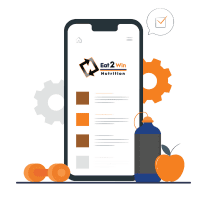
Trackers
Stay on target with cutting-edge trackers that monitor every step of your journey, ensuring you never miss a beat.
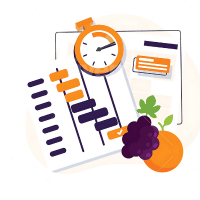
Meal Plan Guides
Simplify your nutrition with easy-to-follow, personalized meal plans that fuel your performance.
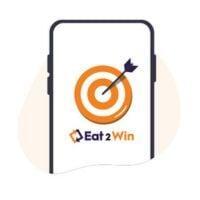
Gamification
Stay motivated and engaged by earning rewards and climbing leaderboards as you hit your fitness and nutrition goals.

Access a Sports Dietitian
Get expert guidance and personalized support from a certified Sports Dietitian whenever you need it.
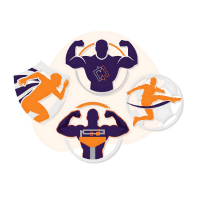
Personalized Programs
Unlock your full potential with personalized programs meticulously crafted to match your unique lifestyle and fitness aspirations.

